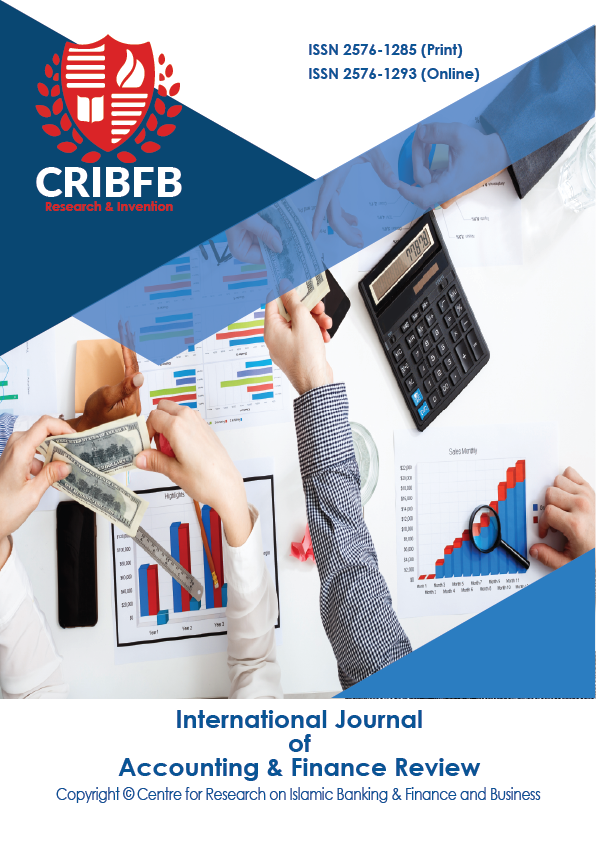An Empirical Study into Comparing Conventional and Islamic Banks in the UAE
Main Article Content
Abstract
Banking system constitutes the fundamental pillar of every economy. Banks acts financial intermediaries between sectors that have excess funds and those that are in deficit. Islamic banks operate under Sharia principles of risk sharing and interest prohibition as contrasted with conventional banks that buy capital to pool funds and sell capital to generate interest income or profit. This paper applies banks’ internal factors related to their balance sheet and income statement and using a total of 23 financial ratios pertaining to the internal factors, it attempts to compare and contrast between conventional and Islamic banks. This research explains the structure, operation and management of banks in the UAE coupled with the functioning of Islamic banks. The paper also aims to determine the profitable and efficient banks among the chosen sample. The sample includes 12 banks, equally distributed between Islamic and conventional banks using data between the periods of 2014 - 2018. The sample is broadly categorized based on profitability ratio, efficiency ratio, asset indicator ratio and risk ratios. Correlation and Regression analysis is used to determine a substantial ratio analysis between conventional and Islamic banks. Results from the study reveal indicators of financial characteristics such as profitability ratios, efficiency ratios, asset quality indicators and risk/ risk management ratios. The results clarify that Islamic banks are operationally efficient and profitable because of risks sharing and greater dependency on deposits capital. However, on an overall basis, the ratios indicate conventional banks have higher scores than their counterparts.
JEL Classification Codes: F37.
Downloads
Article Details
Section
How to Cite
References
Al-Ajmi, J., Hussain, H. A., & Al-Saleh, N. (2009). Clients of conventional and Islamic banks in Bahrain: How they choose which bank to patronize. International Journal of Social Economics, 36(11), 1086–1112.
Al-Hassan, A., Khamis, M., & Oulidi, N. (2010). The GCC banking sector: Topography and analysis. Banks and Banks Systems, 5(3), 15–28.
Al-Muharrami, S., & Matthews, K. (2009). Market power versus efficient-structure in Arab GCC banking. Working paper No.7, Cardiff business school.
Al-Tamimi, H. A., & Al-Amiri, A. (2003). Analyzing service quality in the UAE Islamic banks. Journal of Financial Services Marketing, 8(2), 119−132
Bashier, B. A. (1983). Portfolio management of Islamic banks: A certainty approach. Journal of Banking and Finance, 7(3), 339−354.
Beck, T., Demirgüç-Kunt, A., & Merrouche, O. (2010). Islamic vs. conventional banking: Business model, efficiency and stability. The World Bank.
Coats, P., & Fant, L. (1993). Recognizing financial distress patterns using a neural network tool. Financial Management, 22(3), 142−155.
Demirgue-Kunt, A., & Hizinga, H. (1999). Determinants of commercial bank interest margins and profitability: Some international evidence. The World Bank Economic Review, 13(2), 379−408.
Essayyad, M., & Madani, H. (2003). Investigating bank structure of an open petroleum economy: The case of Saudi Arabia. Managerial Finance, 29(11), 73−92.
Grais, W., & Pellegrini, M. (2006). Corporate governance and Sharia compliance in institutions offering Islamic financial services. World Bank policy working paper: 4054, November, 2006 (pp. 1−34).
Hanif, M., Tariq, M., & Tahir, A. (2012). Comparative performance study of conventional and Islamic banking in Pakistan. International Research Journal of Finance & Economics, (83).
Hume, J. (2004). Islamic finance: Provenance and prospects. International Financial Law Review, 23(5), 1−4.
Hussain, M., Islam, M., Gunasekaran, A., & Maskooki, K. (2002). Accounting standards and practices of financial institutions in GCC countries. Managerial Auditing Journal, 17(7), 350−362.
Iqbal, M. (2006). A broader definition of Riba: Pakistan Institute of Development Economics working paper. Institute of Islamic Banking and Insurance.
Islam, M. (2003). Development and performance of domestic and foreign banks in the GCC countries.
Kapur, M. (2020) Performance of Conventional and Islamic Banks in the UAE: A Comparative Graphical Ratio Analysis.
Mehta, A., & Bhavani, G. (2017). What determines banks’ profitability? evidence from emerging markets–the case of the UAE ban king sector. Accounting and Finance Research, 6(1), 77-88.
Menicucci, E., & Paolucci, G. (2016). The determinants of bank profitability: empirical evidence from European banking sector. Journal of financial reporting and Accounting
Merchant, I. P. (2012). Empirical study of Islamic banks versus conventional banks of GCC. Global Journal of Management and Business Research, 12(20).
Pradhan, R. S., & Shrestha, R. (2016). Impact of Bank Specific and Macroeconomic Variables on the Performance of Commercial Banks of Nepal. Available at SSRN 2793530
Rosly, S. A., & Bakar, M. A. A. (2003). Performance of Islamic and mainstream banks in Malaysia. International Journal of Social Economics.
Annual Financial Statement of the Conventional and Islamic banks in the UAE
Abu Dhabi Commercial Bank (ADCB), 2014, 2015, 2016, 2017, 2018
Abu Dhabi Islamic Bank (ADIB), 2014, 2015, 2016, 2017, 2018
Al Hilal Bank (AHB), 2014, 2015, 2016, 2017, 2018
Commercial Bank Dubai (CBD), 2014, 2015, 2016, 2017, 2018
Dubai Islamic Bank (DIB), 2014, 2015, 2016, 2017, 2018
Emirates Islamic Bank (EIB), 2014, 2015, 2016, 2017, 2018
Emirates NBD (ENBD), 2014, 2015, 2016, 2017, 2018
First Abu Dhabi Bank (FAB), 2016, 2017, 2018
First Gulf Bank (FGB), 2014, 2015
Mashreq Bank, 2014, 2015, 2016, 2017, 2018
National Bank of Abu Dhabi (NBAD), 2014, 2015
Noor Bank (Noor), 2014, 2015, 2016, 2017, 2018
RAK Bank (RAK), 2014, 2015, 2016, 2017, 2018
Sharjah Islamic Bank (SIB), 2014, 2015, 2016, 2017, 2018




